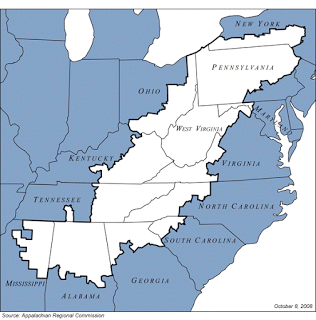Cancer, and death from it, rose in rural Appalachia from 1969 to 2011; Appalachian Kentucky’s cancer-death rate was 36% higher

 |
| Appalachian Regional Commission service area |
From 1969 to 2011 the cancer death rate in rural Appalachia went from the nation’s lowest to its highest, says a study at the University of Virginia researchers, published in the Journal of Rural Health. The study, which used data from 23,565 men and 37,847 women first studied in 1999, found that cancer mortality rates were higher in every rural Appalachian area—except in Maryland—than in urban areas.
From 1969 to 2011, “Cancer incidence declined in every region of the country except rural Appalachia, where it increased,” Josh Barney reports for UVA Today. “In the rural Appalachian areas of Kentucky, mortality rates were 36 percent higher. People in Appalachia are more likely to die within three to five years of their cancer diagnoses than people in urban areas outside Appalachia.”
One possibility for higher rural cancer death rates is a lack of screening, researchers said. Among people 50 or older living in Appalachia, 16.2 percent of rural residents received a fecal occult blood test in the past year, compared to 22 percent in urban areas. Also, 28.2 percent of rural residents had a colonoscopy in the past five years, compared to 35.2 percent in urban areas.
Researchers said other factors affecting rural areas include a lack of health care, transportation hurdles to seek care, higher poverty, smoking and obesity rates and a rural attitude of fiercely independent people who refuse to seek care.